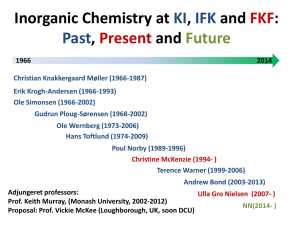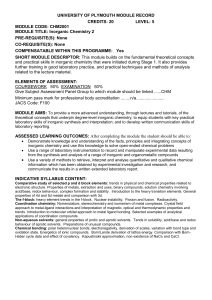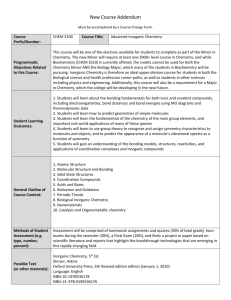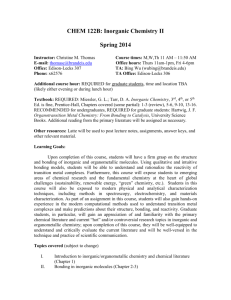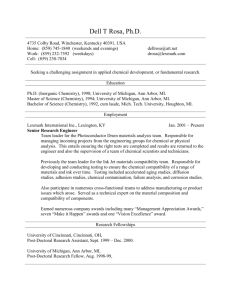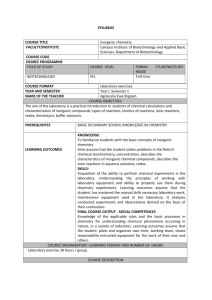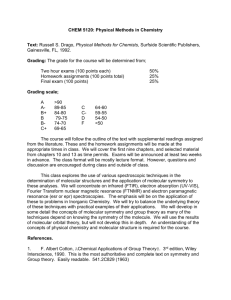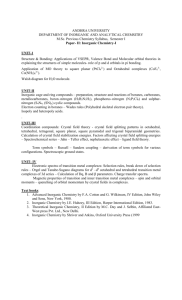Chemistry 4610 - The University of West Georgia
advertisement
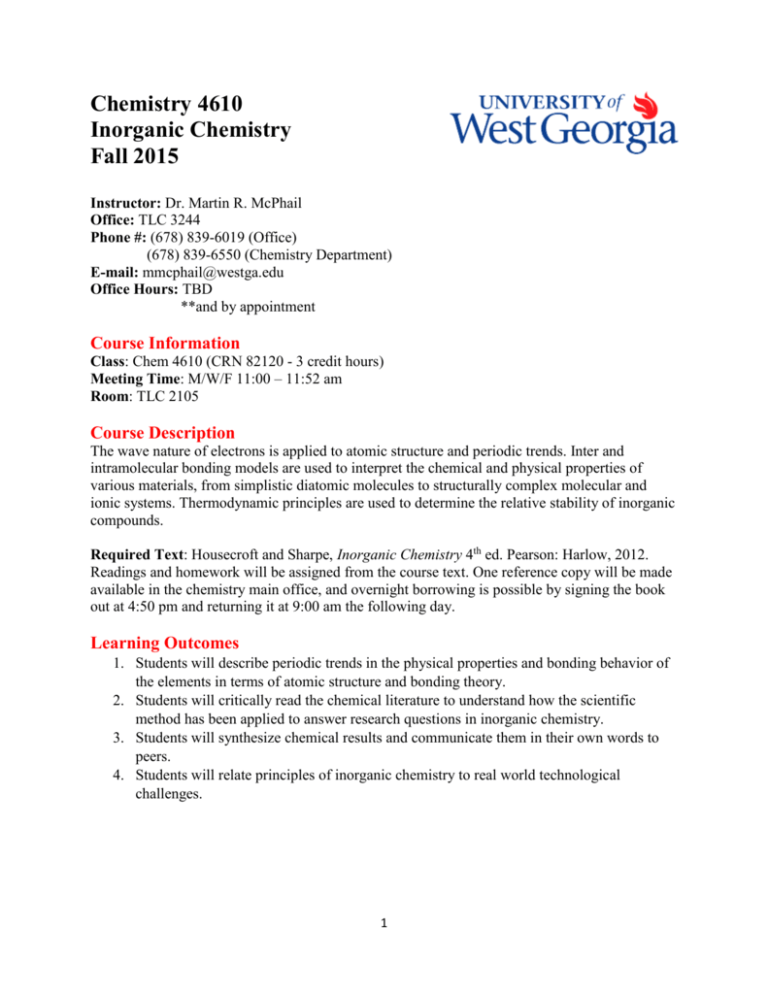
Chemistry 4610 Inorganic Chemistry Fall 2015 Instructor: Dr. Martin R. McPhail Office: TLC 3244 Phone #: (678) 839-6019 (Office) (678) 839-6550 (Chemistry Department) E-mail: mmcphail@westga.edu Office Hours: TBD **and by appointment Course Information Class: Chem 4610 (CRN 82120 - 3 credit hours) Meeting Time: M/W/F 11:00 – 11:52 am Room: TLC 2105 Course Description The wave nature of electrons is applied to atomic structure and periodic trends. Inter and intramolecular bonding models are used to interpret the chemical and physical properties of various materials, from simplistic diatomic molecules to structurally complex molecular and ionic systems. Thermodynamic principles are used to determine the relative stability of inorganic compounds. Required Text: Housecroft and Sharpe, Inorganic Chemistry 4th ed. Pearson: Harlow, 2012. Readings and homework will be assigned from the course text. One reference copy will be made available in the chemistry main office, and overnight borrowing is possible by signing the book out at 4:50 pm and returning it at 9:00 am the following day. Learning Outcomes 1. Students will describe periodic trends in the physical properties and bonding behavior of the elements in terms of atomic structure and bonding theory. 2. Students will critically read the chemical literature to understand how the scientific method has been applied to answer research questions in inorganic chemistry. 3. Students will synthesize chemical results and communicate them in their own words to peers. 4. Students will relate principles of inorganic chemistry to real world technological challenges. 1 Course Assessment Students’ progress towards mastery of the learning outcomes will be tracked and assessed via: Lecture Attendance [Outcome 1, 2, 4] I will focus in lecture on developing the concepts presented in the text from fundamental concepts and connecting their importance to various research topics in inorganic chemistry. You will be responsible for all material covered in lecture as well as the assigned readings, so coming on time and actively participating in the lecture will be important for success. Lecture attendance is mandatory. Arriving to class after lecture has commenced will count as an absence. You will be allowed two free absences without a point reduction. Any additional absences will result in a point loss except in the case of an emergency where official documentation can be provided. Powerpoint slides will be made available prior to each lecture to facilitate preparation and note taking. Recording of lectures is permitted. Reading Questions [Outcome 1] Given the breadth of material that falls under the category of inorganic chemistry, we will need to move quickly through the various topics. This means it is important for you, the student, to prepare beforehand for each lecture session by reading the text to be covered and making notes of important questions you have. This will allow us to devote more time in lecture to answering your questions, discussing important concepts, and working through practice examples. To facilitate critical reading of the text and preparation for lecture you will be provided with a short set of reading questions prior to each lecture that must be completed and turned in at the beginning of that lecture period. These will include graded questions pertaining to the reading material as well as a non-graded question asking what concepts you found the most difficult. Reading questions are meant to help your prepare for class, and so will not be accepted late. Homework [Outcome 1, 2, 4] Homework will be assigned on a weekly basis through CourseDen and must be turned in at the beginning of class on the following Monday. Late homework will not be accepted. All work must be shown to receive full credit for the assignment. Homework allows for the reinforcement of key concepts and feedback between student and instructor. Homework will be drawn from the Housecroft text as well as questions created by myself. Literature Review Project [Outcome 2, 3, 4] The field of inorganic chemistry comprises an incredibly wide and rapidly advancing area of research with critical applications to the technological challenges of the 21st century including medicine, materials, energy, and nanotechnology. A critical skill for a professional scientist is the ability to read, understand, and synthesize the literature of a given topic to create a picture of the current state of the field and the directions it is moving in. To practice these skills you and a partner will choose a topic of current research interest in inorganic chemistry, find a series of recent articles published on the topic, individually write a report summarizing your findings, and prepare a presentation that summarizes and explains the topic to the class. Topic Choice – You may either choose a topic from a provided list or propose another topic, which will have to be approved by me. 2 Literature Review – Your will have to find five peer-reviewed, non-review articles published within the past ten years, two of which were published within the past five years, and have them approved by myself. Written Summary – You will individually synthesize your review of the literature into a fourpage, double-spaced written summary of the topic. The summary should include a brief introduction to the research topic in general, a description of the techniques and methods used in the papers you read, a discussion of the common themes and findings between your sources, and a outlook on the future directions of the topic. This summary should be clear, concise, and written to introduce a peer to the topic. Remember that good review articles provide connections and perspective. Presentation – Your group will give a Powerpoint-based presentation that summarizes your research into the topic and effectively communicates this to the class. The objective of this project is to synthesize and communicate the information you have found in your own words. The presentation should include an introduction to the topic in general, the specific research questions addressed in the articles you found, the techniques used to answer these questions, and the future directions of this research topic. Exams [Outcome 1] The two midterm exams (Exam 1 & 2) will include all material covered up to and including the lecture one week prior to the exam date. These will not be comprehensive, so Exam 2 will not cover material tested on Exam 1 The final exam will be comprehensive. All exams will be in paper format. All work must be shown in order to receive full credit. Final answers must be clearly indicated by circling or boxing. A periodic table and necessary equations will be provided on each exam such that needless memorization of formulas is not necessary. A list of these equations will be provided beforehand. Scientific and graphing calculators are permitted, but the use of programs on these devices is prohibited. Calculator applications on phones, tablets, laptops, or other electronic devices are not permitted. Make-up Policy Assignments are due on the dates specified in the course schedule. Failure to turn in assignments on time will result in a “0” for each missed assignment. Make-up assignments and exams will only be possible in the case of emergencies, and you should contact me within 24 hours if such an emergency arises. Make-up assignments should be completed and turned in within one week of the original deadline unless this is not allowed by the nature of the emergency. Arrangements for make-up exams will be made between myself and the student. Assessment Grading Lecture Attendance 10% Reading Questions 10% Homework 15% Literature Review Project 15% Exam 1 15% Exam 2 15% Final Exam 20% 3 Grading Scale A 90 – 100 B 80 – 89 C 70 – 79 D 60 – 69 F 0 – 59 Grading Turnaround: Shorter assignments and assessments will be graded and returned within one week of the due date. Longer assignments such as the literature review may take longer to grade and return. I will keep you updated on the progress of my grading. No Extra Credit is accepted for this course Course Policies and Information University Policies and Academic Support Please review the Common Language for all university course syllabi at the address: http://www.westga.edu/assetsDept/vpaa/Common_Language_for_Course_Syllabi.pdf This document contains important information regarding university policies and responsibilities. You should regularly review these statements because they are updated as federal, state, university, and accreditation standards change. Academic Honesty Any form of academic dishonesty—including but not limited to cheating or plagiarism—will result in a failing grade on the relevant assignment as well as possible additional action. Please be familiar with the definitions of academic dishonesty and plagiarism as laid out in the Student Handbook, which can be found at the link: http://www.westga.edu/handbook/ Disabilities Act / Accessibility for the Course If you are a student with a disability as defined under the Americans with Disabilities Act and require assistance or support services, please notify me and provide me with a copy of your packet from Student Services. The university will provide you with resources for any audio/visual needs that you may have with the learning management system or course content. It is critical that you contact UWG Accessibility Services immediately to find out what accommodations are necessary so we can work together to facilitate your success in this class. Please consult the UWG Accessibility Services site http://www.westga.edu/accessibility or call (678) 839-6428 for more details regarding accessibility for this course. Student Conduct Students are obligated to abide by conduct guidelines as described in the university catalog. Respect and courtesy of all students while in the classroom is required. The following are also mandatory: 4 1. Any disruptive behavior will result in your expulsion from the room. If disruptive behavior persists you will receive a minimum of a one letter-grade deduction from your overall grade as well as possible additional action depending on the severity of the behavior. 2. All electronic devices must be silenced during lecture. Calls may only be answered in the case of emergencies by stepping out into the hall. Headphones are not permitted to be worn during lecture. Laptops and tablets are permitted, but if your use of these devices becomes disruptive their use will be disallowed for the remainder of the semester. Please feel free to contact me with any questions regarding the above. Following “common sense” behavior should prevent any of the above problems. Failure to adhere to conduct guidelines could result in dismissal from class, a deduction from your final course grade, as well as further disciplinary action. Note on Syllabus Modifications I reserve the right to modify this syllabus at any time during the course of the term, particularly with regards to course schedule. Students will be notified of all syllabus modifications. In a case where a substantial modification is required, I will reissue a revised syllabus. Tentative Course Schedule Month Day Lecture Topics Aug 24 M 26 W 28 F 31 M Sept 2W 4F Syllabus Overview Intro to Inorganic Chem Atomic Structure Atomic Orbitals Many-electron atoms Aufbau Principle The Periodic Table Ionization Energies and Electron Affinity Valence Bond and Molecular Orbital Theories of Homonuclear Diatomic Molecules Electronegativity and Dipole Moments Heteronuclear Diatomic Molecules Molecular Shape and Stereoisomerism Hard Sphere Packing Polymorphism and Phase Changes in Metals Melting Points and Enthalpies of Atomization of Metals 5 Reading (Housecroft) 1.1 – 1.6 Assignments 1.7 – 1.10 2.1 – 2.6 2.7 – 2.9 6.1 – 6.4 6.5 – 6.7 HW 1 Due 7M 9W 11 F 14 M 16 W 18 F 21 M 23 W 25 F 28 M 30 W Oct 2F 5M 7W 9F Alloys and Intermetallic Compounds Labor Day No Class Bonding in Metals and Semiconductors Ionic Lattice Structures Lattice Energies and Defects Diffraction Methods Electrical Conductivity in Ionic Solids Properties of Water Acid and Base Definitions Acid Dissociation Energetics Aquated Cations Amphoteric Behavior Ionic Salt Solubility Common-ion Effect Overview of Non-Aqueous Media Relative Permittivity Acid-Base Behavior in NonAqueous Media Standard Reduction Potentials and Important Thermodynamic Quantities Disproportionation Reactions Potential Diagrams Frost-Ebsworth Diagrams Relating Redox Potentials to Experimentally Important Quantities and Applications d-Block Metals Intro Electronic Structure Physical Properties Reactivities Characteristic Properties Electroneutrality Principle Exam 1 Coordination Numbers Isomerism Introduction to Coordination Complexes Stability of Coordination Complexes High and Low Spin States Crystal Field Theory 6 6.8 – 6.12 HW 2 Due 6.13 – 6.17; 4.11; 28.2 Review Topic Deadline 7.1 – 7.5 HW 3 Due 7.6 – 7.10 9.1 – 9.4 8.1, 8.2 HW 4 Due 8.3 – 8.5 8.6 – 8.8 19.1 – 19.4 HW 5 Due 19.5 – 19.6 19.7 – 19.8 HW 6 Due 7.11 – 7.13 20.1, 20.3 Literature Review Sources Due 12 M 14 W 16 F 19 M 21 W 23 F 26 M 28 W 30 F Nov 2M 4W 6F 9M 11 W 13 F 16 M 18 W 20 F 21 M 23 W 25 F MO Theory of Octahedral Complexes Ligand Field Theory Quantum Numbers for Multielectron Systems (L, S, and J) Electronic Absorption and Emission Spectra Nephelauxetic Effect EPR Spectroscopy Magnetic Properties Ligand Field Stabilization Energy Irving-Williams Series Oxidation States in (aq) d-Block Organometallics: Common types of ligands and Bonding Metal Carbonyls Isolobal Principle Total Valence Electron Counting Alkyl, Aryl, Alkene, and Alkyne Complexes Allyl and buta-1,3-diene complexes Carbene and Carbyne Complexes Metallocenes Examples of Organometallic Reactions Ligand Substitution Kinetics Octahedral Substitution Exam 2 Electron Transfer Introduction to Catalysis Homogeneous Catalysts Heterogeneous Catalysts Metalloprotein Introduction Dealing with O2 Biological Redox Processes f-Orbitals and Oxidation States Atom and Ion Sizes Spectroscopic and Magnetic Properties Thanksgiving Break No Class Thanksgiving Break No Class Thanksgiving Break No Class 7 20.4 – 20.5 HW 7 Due 20.6 4.7; 20.7 – 20.8 4.9; 20.9 – 20.10 HW 8 Due 20.11 – 20.13 24.1 – 24.3 24.4 – 24.6 HW 9 Due 24.10 – 24.12 24.13 – 24.15; 24.7 Written Literature Review Draft Due 26.1 – 26.3 26.4 HW 10 Due 26.5 25.1 – 25.4, 25.6 25.7 – 25.9 29.1, 29.3 HW 11 Due 29.4 27.1 – 27.6 HW 12 Due Written Literature Review Final Draft Due Dec 30 M 2W 4F 11 F Review Day Presentation Day Presentation Day FINAL EXAM 11:00-1:30 pm Location: TBA HW 13 Due 8

